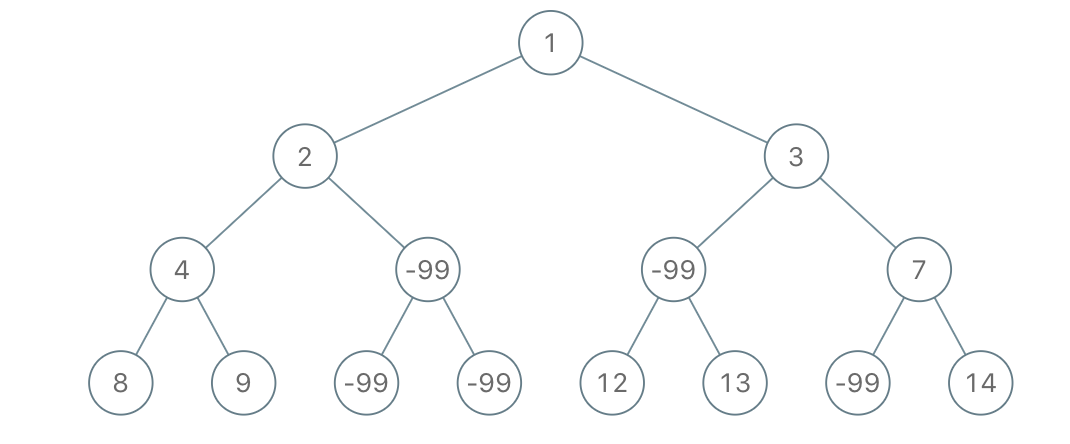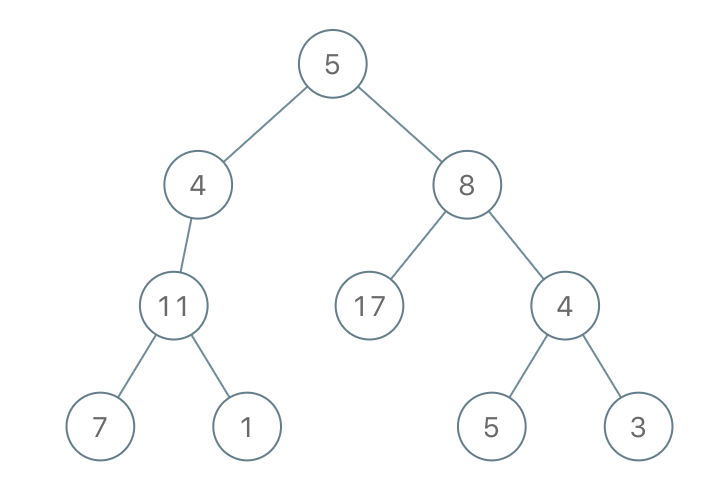Welcome to Subscribe On Youtube
1080. Insufficient Nodes in Root to Leaf Paths
Description
Given the root of a binary tree and an integer limit, delete all insufficient nodes in the tree simultaneously, and return the root of the resulting binary tree.
A node is insufficient if every root to leaf path intersecting this node has a sum strictly less than limit.
A leaf is a node with no children.
Example 1:

Input: root = [1,2,3,4,-99,-99,7,8,9,-99,-99,12,13,-99,14], limit = 1 Output: [1,2,3,4,null,null,7,8,9,null,14]
Example 2:

Input: root = [5,4,8,11,null,17,4,7,1,null,null,5,3], limit = 22 Output: [5,4,8,11,null,17,4,7,null,null,null,5]
Example 3:

Input: root = [1,2,-3,-5,null,4,null], limit = -1 Output: [1,null,-3,4]
Constraints:
- The number of nodes in the tree is in the range
[1, 5000]. -105 <= Node.val <= 105-109 <= limit <= 109
Solutions
-
/** * Definition for a binary tree node. * public class TreeNode { * int val; * TreeNode left; * TreeNode right; * TreeNode() {} * TreeNode(int val) { this.val = val; } * TreeNode(int val, TreeNode left, TreeNode right) { * this.val = val; * this.left = left; * this.right = right; * } * } */ class Solution { public TreeNode sufficientSubset(TreeNode root, int limit) { if (root == null) { return null; } limit -= root.val; if (root.left == null && root.right == null) { return limit > 0 ? null : root; } root.left = sufficientSubset(root.left, limit); root.right = sufficientSubset(root.right, limit); return root.left == null && root.right == null ? null : root; } } -
/** * Definition for a binary tree node. * struct TreeNode { * int val; * TreeNode *left; * TreeNode *right; * TreeNode() : val(0), left(nullptr), right(nullptr) {} * TreeNode(int x) : val(x), left(nullptr), right(nullptr) {} * TreeNode(int x, TreeNode *left, TreeNode *right) : val(x), left(left), right(right) {} * }; */ class Solution { public: TreeNode* sufficientSubset(TreeNode* root, int limit) { if (!root) { return nullptr; } limit -= root->val; if (!root->left && !root->right) { return limit > 0 ? nullptr : root; } root->left = sufficientSubset(root->left, limit); root->right = sufficientSubset(root->right, limit); return !root->left && !root->right ? nullptr : root; } }; -
# Definition for a binary tree node. # class TreeNode: # def __init__(self, val=0, left=None, right=None): # self.val = val # self.left = left # self.right = right class Solution: def sufficientSubset( self, root: Optional[TreeNode], limit: int ) -> Optional[TreeNode]: if root is None: return None limit -= root.val if root.left is None and root.right is None: return None if limit > 0 else root root.left = self.sufficientSubset(root.left, limit) root.right = self.sufficientSubset(root.right, limit) return None if root.left is None and root.right is None else root -
/** * Definition for a binary tree node. * type TreeNode struct { * Val int * Left *TreeNode * Right *TreeNode * } */ func sufficientSubset(root *TreeNode, limit int) *TreeNode { if root == nil { return nil } limit -= root.Val if root.Left == nil && root.Right == nil { if limit > 0 { return nil } return root } root.Left = sufficientSubset(root.Left, limit) root.Right = sufficientSubset(root.Right, limit) if root.Left == nil && root.Right == nil { return nil } return root } -
/** * Definition for a binary tree node. * class TreeNode { * val: number * left: TreeNode | null * right: TreeNode | null * constructor(val?: number, left?: TreeNode | null, right?: TreeNode | null) { * this.val = (val===undefined ? 0 : val) * this.left = (left===undefined ? null : left) * this.right = (right===undefined ? null : right) * } * } */ function sufficientSubset(root: TreeNode | null, limit: number): TreeNode | null { if (root === null) { return null; } limit -= root.val; if (root.left === null && root.right === null) { return limit > 0 ? null : root; } root.left = sufficientSubset(root.left, limit); root.right = sufficientSubset(root.right, limit); return root.left === null && root.right === null ? null : root; } -
/** * Definition for a binary tree node. * function TreeNode(val, left, right) { * this.val = (val===undefined ? 0 : val) * this.left = (left===undefined ? null : left) * this.right = (right===undefined ? null : right) * } */ /** * @param {TreeNode} root * @param {number} limit * @return {TreeNode} */ var sufficientSubset = function (root, limit) { if (root === null) { return null; } limit -= root.val; if (root.left === null && root.right === null) { return limit > 0 ? null : root; } root.left = sufficientSubset(root.left, limit); root.right = sufficientSubset(root.right, limit); return root.left === null && root.right === null ? null : root; };